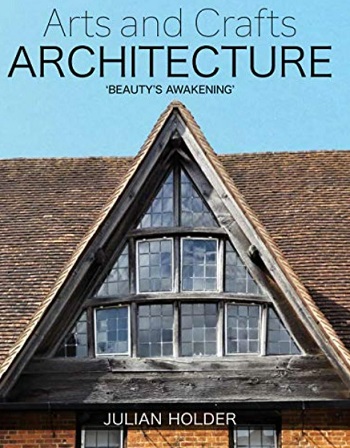Arts and Crafts Architecture: 'Beauty's Awakening'
Arts and Crafts Architecture: ;Beauty's Awakening' Julian Holder, Crowood Press, 2021, 176 pages, colour and black and white illustrations, hardback.
Architectural historians have often struggled to define the principles on which arts-and-crafts architecture have been based. The first serious attempt was made by Peter Davey, whose book ‘Arts and Crafts Architecture: the search for earthly paradise’ was published in 1982. Since then there have been monographs of leading figures such as Philip Webb, CFA Voysey, Baillie Scott, CR Ashbee and Ernest Gimson, and recently Alec Hamilton’s revealing book ‘Arts and Crafts Churches’. Now Julian Holder provides an ambitious overview of the movement, exploring its origins, ethics, politics and philosophy, and the buildings themselves.
Part of the problem faced by writers has been how to relate the architecture and the broader arts-and-crafts movement. Holder tackles the point head on by arguing that architects were the dominant figures, many – such as Ashbee, Gimson and Sidney Barnsley – moving on to embrace craftsmanship, including furniture making, silversmith and metal working. He places William Morris, who trained as an architect, along with Webb, Edward Prior, WR Lethaby, MH Baillie-Scott and Gimson as key figures. Another problem is that since the arts and crafts were a set of ideas and not a style, it is not always easy to identify the products of the movement.
A strength of the book is its structure, which helps the reader to understand the complex background to the movement, before describing the architecture. Each of the chapters contains a case study, which analyses a particular building in some detail with plans and many well-chosen photographs. These help to identify the qualities of each of the major architects. Baillie-Scott is credited for conceptualising each room of a house as a work of art, and for working closely with craftsmen in every aspect from the furniture and fabrics down to the metalwork and stained glass. Prior is praised for his inventiveness and his feeling for textural effect in the use of materials based on the local vernacular. Lutyens is featured, but Holder questions whether he should be, given his stylistic eclecticism.
The most original and compelling chapter is the final one, which is titled ‘The Garden City Movement: arts and crafts for all’. This makes the case that the movement’s greatest achievement was the part it played in the establishment of garden cities, the Housing Act 1919 and the introduction of town planning in Britain. To make his point he traces links between William Morris’ utopian ideas and Ebenezer Howard’s ‘Tomorrow: a peaceful path to real reform’, and how these ideas were to influence government housing policy after the first world war and the huge programme of council housing that was to follow.
The only issue that might disappoint some readers, and which is not obvious from its title, is that the book focuses almost entirely on the arts and crafts in England (to have included Scotland, Wales and Northern Ireland would have required a somewhat larger volume). But for those who are happy to stick with the English story, this is a valuable and very readable addition to the growing literature on the arts-and-crafts movement.
This article originally appeared as ‘A set of ideas, not a style’ in the Institute of Historic Building Conservation’s (IHBC’s) Context 174, published in December 2022. It was written by Peter de Figueiredo, reviews editor for Context .
--Institute of Historic Building Conservation
Related articles on Designing Buildings
IHBC NewsBlog
Old Sarum fire in listed (& disputed) WW1 Hangar - Wiltshire Council has sought legal advice after fire engulfed a listed First World War hangar that was embroiled in a lengthy planning dispute.
UK Antarctic Heritage Trust launches ‘Virtual Visit’ website area
The Trust calls on people to 'Immerse yourself in our heritage – Making Antarctica Accessible'
Southend Council pledge to force Kursaal owners to maintain building
The Council has pledged to use ‘every tool in the toolbox’ if urgent repairs are not carried out.
HE’s Research Magazine publishes a major study of the heritage of England’s suburbs
The article traces the long evolution of an internal programme to research 200 years of suburban growth
IHBC Context 183 Wellbeing and Heritage published
The issue explores issues at the intersection of heritage and wellbeing.
SAVE celebrates 50 years of campaigning 1975-2025
SAVE Britain’s Heritage has announced events across the country to celebrate bringing new life to remarkable buildings.
IHBC Annual School 2025 - Shrewsbury 12-14 June
Themed Heritage in Context – Value: Plan: Change, join in-person or online.
200th Anniversary Celebration of the Modern Railway Planned
The Stockton & Darlington Railway opened on September 27, 1825.
Competence Framework Launched for Sustainability in the Built Environment
The Construction Industry Council (CIC) and the Edge have jointly published the framework.
Historic England Launches Wellbeing Strategy for Heritage
Whether through visiting, volunteering, learning or creative practice, engaging with heritage can strengthen confidence, resilience, hope and social connections.
















Comments
[edit] To make a comment about this article, or to suggest changes, click 'Add a comment' above. Separate your comments from any existing comments by inserting a horizontal line.